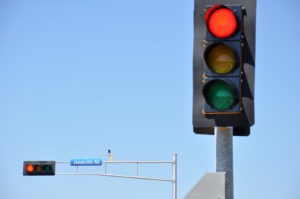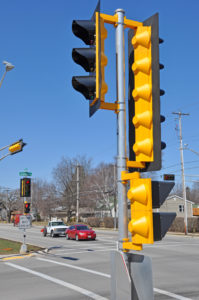Why You Should LOVE Traffic Engineering
 When you’re running late for work and stuck at yet another red light, the science of traffic engineering might not be the first thing that comes to mind. However, keeping traffic moving smoothly and efficiently depends largely on the work of traffic engineers. From figuring out the optimum timing for a traffic signal to analyzing crash data to make an intersection safer, traffic engineers are committed to providing safe, efficient travel for all users of streets and roadways.
When you’re running late for work and stuck at yet another red light, the science of traffic engineering might not be the first thing that comes to mind. However, keeping traffic moving smoothly and efficiently depends largely on the work of traffic engineers. From figuring out the optimum timing for a traffic signal to analyzing crash data to make an intersection safer, traffic engineers are committed to providing safe, efficient travel for all users of streets and roadways.
 How long should a light stay green? When is a four-way stop appropriate? When is a left-turn arrow needed? These are all questions traffic engineers analyze. And they use cutting-edge technology, models, and design practices to develop creative solutions that meet the needs of a specific location, whether it be safety crosswalks for pedestrian traffic near a school or a roundabout for an accident-prone intersection.
How long should a light stay green? When is a four-way stop appropriate? When is a left-turn arrow needed? These are all questions traffic engineers analyze. And they use cutting-edge technology, models, and design practices to develop creative solutions that meet the needs of a specific location, whether it be safety crosswalks for pedestrian traffic near a school or a roundabout for an accident-prone intersection.
Traffic Engineering Takes Many Forms
Some of the things traffic engineers love to do include:

- Intersection and corridor capacity analysis
- Traffic signal design, operations, and timings
- Work zone user delay analysis
- Corridor planning
- Intersection control analysis (stop, signal, and roundabout)
- Origin-destination studies
- Pedestrian, school, and bicycle studies
- Traffic impact analysis (TIA) and peer review
- Traffic modeling and microsimulation
- Traffic data collection – counting vehicles and pedestrians and documenting vehicle speeds
- Crash and safety analysis
- Roundabout design and analysis
- Signing and pavement marking design and evaluation
Ultimately traffic engineers help keep traffic moving smoothly and efficiently – a crucial need when gas prices rise and driver patience wanes. The Institute of Transportation Engineers (ITE) and the National Transportation Operations Coalition issued its latest National Traffic Signal Report Card in 2012. This report card gave the nation an overall grade of “D+” for traffic signal operation. The ITE study said inefficiency leads to frustration and unnecessary delays for motorists, wasted fuel, and more air pollution as vehicles constantly stop and go.
Traffic Signal Optimization Keeps Traffic Moving
Engineers can help improve this grade through many traffic signal optimization strategies and tools. Travel patterns are constantly changing, and that means traffic signal timing should be updated every three to five years. Traffic engineers specialize in coordinating signal systems. They study the movement of traffic along a roadway and optimize signal timings to keep traffic moving smoothly.
 A well-planned traffic signal system can deliver many benefits to your community:
A well-planned traffic signal system can deliver many benefits to your community:
- More traffic traveling at the posted speed limit
- Fewer side-impact and rear-end collisions
- Reduced use of neighborhood routes to avoid signalized streets
- Maximized street capacity
- An improved pedestrian environment
Traffic engineers study the movement of traffic along a street, test timing plans using software specifically for signal design, and develop timings that work for your community. They provide proactive management for signal operations to track performance and ultimately determine where improvements are needed.
Traffic Signals Designed To Meet Community Needs
Traffic signal design begins with determining the need for a signal and how it should be operated. Traffic experts can design signal and operating plans to operate as fixed time, actuated, or part of a coordinated system. Traffic engineers identify signal control equipment that best meets a community’s needs and is compatible with existing equipment. Other considerations include the volumes of pedestrians and bicyclists present, traffic detection, special lane controls, signal head visibility, pedestrian crossing distances and Americans with Disabilities Act (ADA) requirements, communication systems, and control cabinet placement.
Signal timing and phasing plans can be prepared to maximize the safety and efficiency of existing and new signal installations. Studies have shown that the benefits of investing in signal timing outweigh the costs by 40 to 1. State-of-the-art signal timing software programs are used to identify baseline timing/phasing plans. The plans are then installed in the field and fine-tuned through trained staff observations to maximize their efficiency and minimize traffic delays. When traffic signals are part of a coordinated system, signal timing parameters are fine-tuned to minimize stops and match prevailing travel speeds.
There’s a lot to love about that.

Post a comment: